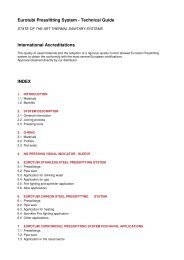Vis PDF - Damstahl
Vis PDF - Damstahl
Vis PDF - Damstahl
Create successful ePaper yourself
Turn your PDF publications into a flip-book with our unique Google optimized e-Paper software.
Chapter 3: Applications of Common Stainless Steel Alloys<br />
EN 1.4512 / AISI 409<br />
Containing only 11 % Cr, the 4512 is the lowest alloyed Ti-Nb-stabilized (and thereby weldable)<br />
ferritic stainless steel. Due to the low Cr, 4512 possesses a comparatively low corrosion resistance;<br />
however, it is weldable and inexpensive and may replace galvanized steel for certain indoor applications.<br />
Due to their excellent resistance against SCC, the ferrites are particularly useful for warm<br />
parts, in particular made of sheets.<br />
EN 1.4521 / AISI 444<br />
Along with the 4509, the “acid resistant ferrite” 4521 is the most interesting and useful ferritic alloy.<br />
Stabilized with Ti and Nb, and apart from a high mechanical strength, 4521 possesses an excellent<br />
corrosion resistance due to 17.0-20.0 % Cr and 1.80-2.50 % Mo. Theory as well as practice have<br />
shown that as regards resistance towards pitting corrosion, 4521 is at least equal to that of ”acid<br />
resistant” 4404 (AISI 316L) and superior to 4301 in chloride containing environments. Like all the<br />
other ferrites, 4521 is superior to its austenitic counterparts with regard to SCC resistance (Chapter<br />
4 + 5) and therefore very useful at higher temperatures (60+ ºC). In short, 4521 is useful for applications<br />
where 4401, 4404 or 4571 are normally used. The main drawbacks are potential difficulties in<br />
welding and the reduced availability; mostly thin sheets and pipes.<br />
EN 1.4526 / (AISI 436)<br />
Nb stabilized steel containing around 17 % Cr and 1.25 % Mo, performing somewhere in between<br />
4301 and 4404 with regard to pitting corrosion. Excellent corrosion resistance against chloride<br />
containing environments and industrial atmosphere and, along with the other ferrites, not prone<br />
to SCC. This makes 4526 ideal for warm or hot parts where the conventional austenites (4301 and<br />
4404 classes) will fail. Can be forged and shaped and, using the right parameters, be assembled<br />
using resistance welding.<br />
Martensitic Stainless Steel:<br />
EN 1.4057 / AISI 431<br />
Hardenable 15-17 % Cr steel, possessing,<br />
relative to the other martensitic steel types,<br />
a fairly good corrosion resistance. Widely<br />
used for making knives and, due to its high<br />
strength, axels. Most easily available as<br />
rods.<br />
EN 1.4104 / (AISI 430F)<br />
Martensitic fine machining steel type containing<br />
up to 0.35 % S and even a small<br />
amount of Mo. Due to its high content of S,<br />
this steel type is very useful for machining.<br />
Sometimes used if one wants a magnetic<br />
fine machine steel grade.<br />
The ideal combination in between hardness and formability.<br />
The blade of this Gense knife has been manufactured from the<br />
martensitic 4057, while the handle has been made of the softer,<br />
but more corrosion resistant 4301.<br />
www.damstahl.com<br />
01.2013<br />
288
















